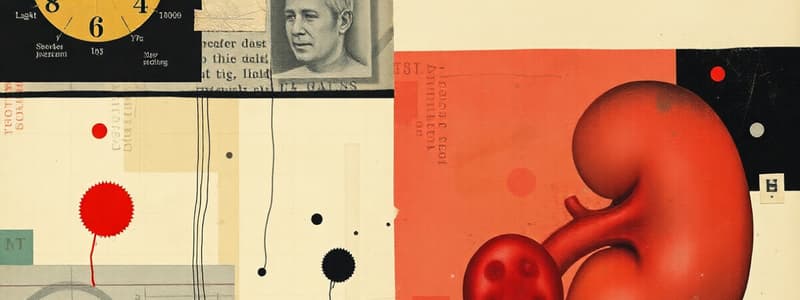Podcast
Questions and Answers
What does a urine pH of less than 5.5 suggest?
What does a urine pH of less than 5.5 suggest?
- Indicates the presence of blood in urine
- Indicates possible kidney stones made of uric acid (correct)
- Suggests high levels of calcium
- Presence of a urinary tract infection
Which test is best suited to identify the size and location of urinary calculi?
Which test is best suited to identify the size and location of urinary calculi?
- Renal Ultrasonography
- 24-Hour Urine Collection
- KUB X-ray
- CT Scan (correct)
What information can a 24-hour urine collection provide?
What information can a 24-hour urine collection provide?
- KID function severity
- Presence of nitrites and bacteria
- Volume, pH, and levels of various electrolytes (correct)
- Visual inspection of calculi
Which serum test is specifically indicated if hyperparathyroidism is suspected?
Which serum test is specifically indicated if hyperparathyroidism is suspected?
Which of the following findings in urinalysis may indicate a urinary tract infection (UTI)?
Which of the following findings in urinalysis may indicate a urinary tract infection (UTI)?
Flashcards are hidden until you start studying
Study Notes
Urinalysis
- Assesses for blood in urine (hematuria), white blood cells, and crystal fragments.
- Urine pH below 5.5 may indicate uric acid stones.
- Presence of nitrites, white blood cells, and bacteria may indicate a urinary tract infection (UTI).
24-Hour Urine Collection
- Measures urine volume, pH, and levels of calcium, oxalate, uric acid, citrate, sodium, and potassium.
- Helps identify causes of kidney stones (lithiasis).
Serum Tests
- Electrolytes and renal function tests assess kidney function and identify factors contributing to stone formation.
- Elevated serum calcium may indicate conditions like hyperparathyroidism, Cushing syndrome, or osteoporosis.
- Serum parathyroid level is measured if hyperparathyroidism is suspected.
Imaging Studies
- KUB X-ray identifies calculi (stones) in the kidneys, ureters, and bladder.
- Renal ultrasonography is preferred during pregnancy and can detect stones and evaluate hydronephrosis (swelling of the kidneys due to blockage).
- CT scan identifies the size and location of calculi, ureteral obstruction, and hydronephrosis.
- Cystoscopy allows for visualization and removal of calculi from the urinary bladder and distal ureters.
Studying That Suits You
Use AI to generate personalized quizzes and flashcards to suit your learning preferences.




